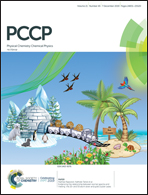Absorption spectra at the iodine 3d ionisation threshold following the CHxI+ (x = 0–3) cation sequence
Abstract
Yields of atomic iodine Iq+ (q ≥ 2) fragments resulting from photoexcitation and photoionisation of the target cations CHxI+ (x = 0–3) have been measured in the photon-energy range 610 eV to 670 eV, which comprises the threshold for iodine 3d ionisation. The measured ion-yield spectra show two strong and broad resonance features due to the excitation of the 3d3/2,5/2 electrons into εf states similar to atomic iodine. In the 3d pre-edge range, electrons are excited into molecular orbitals consisting of iodine, carbon, and hydrogen atomic orbitals. These transitions have been identified by comparison with literature data and by simulations using time-dependent density functional theory (TDDFT) with the KMLYP functional. The ion-yield spectrum for CH3I+ resembles the spectrum of IH+ [Klumpp et al., Phys. Rev. A, 2018, 97, 033401] because the highest occupied molecular orbitals (HOMO) of the H and CH3 fragments both contain a single vacancy, only. For the molecular cations with higher number of vacancies in the valence molecular orbitals CHxI+ (x = 0–2), a stronger hybridisation of the molecular orbitals occurs between the organic fragment and the iodine resulting in a change of bonding from a single σ bond in CH3I+ to a triple bond including two π orbitals in CI+. This is reflected in the resonance energies of the observed absorption lines below the iodine 3d excitation threshold.



 Please wait while we load your content...
Please wait while we load your content...